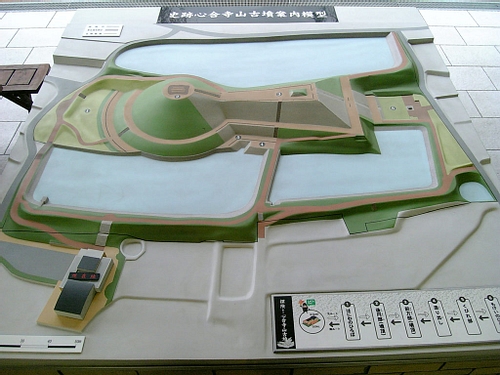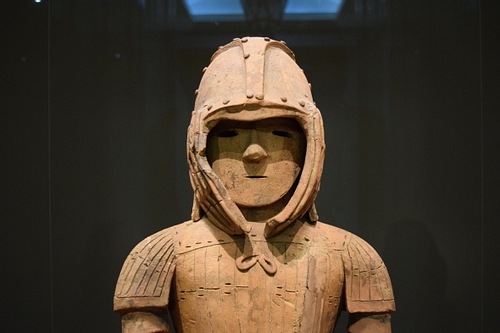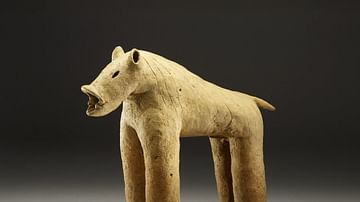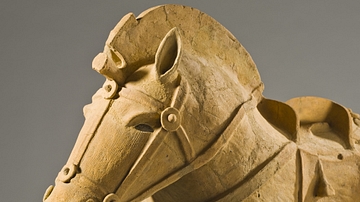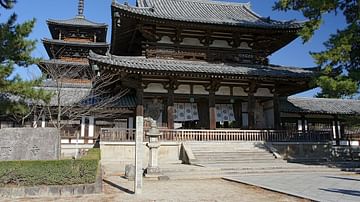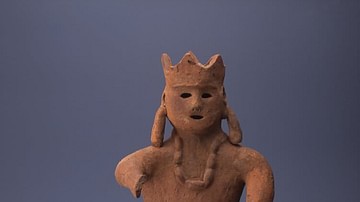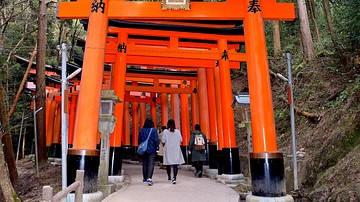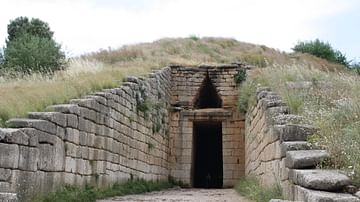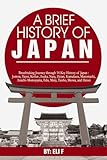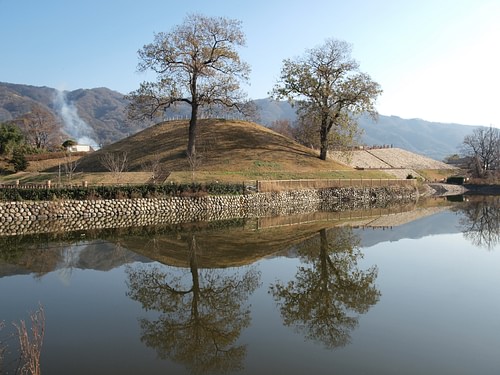
Kofun (old tumuli) are large artificial mound tombs built in ancient Japan for the ruling elite between the 3rd and 7th century CE. Many measure several hundred metres across, are surrounded by a moat, and, besides containing valuable bronze and iron goods, they were protected by terracotta figurines called haniwa. The goods within the tombs illustrate the increasing prosperity of ancient Japan as the rulers of Yamato traded both materials and ideas with neighbouring states. The mounds have given their name to the Kofun Period of Japanese history which covers c. 250 to 538 CE.
Location
Kofun tombs are spread over the Kinai region of Japan which includes the important sites of Nara, Kyoto, and Osaka. The idea of large burial mounds probably spread from contemporary China and Korea where they were also built for burying elite members of society. The earliest mounds were built in the southern plain of Nara, then they appear on the western slopes of the hills above Nara, and finally, they are concentrated on the eastern shores facing the Inland Sea (Sea of Japan). The practice of building kofun eventually spread throughout Japan so that the islands boast some 20,000 burial mounds known today.
Design
Many early kofun were constructed to include natural mounds which were then developed to increase their size. From the 5th century CE, it was more common for kofun to be constructed on flat ground. The earlier examples, from c. 250 CE, are circular but later kofun follow a pattern and have a keyhole form design. Inside the earth mound is a stone-lined chamber in which was placed the body of the deceased. Many tombs are surrounded by a moat or shallow canal.
The smallest kofun are around 15 metres in diameter, many of the 140 in the Kibi area are over 27 metres high and 335 metres long, while the largest of all kofun can cover over 80 acres. One giant kofun is that of Emperor Ojin (r. 270-310 CE) which is 415 metres long and stands 35 metres tall. Another of the biggest tombs is that of Emperor Nintoku, Ojin's successor, which is also located in the modern Osaka Prefecture. It is 823 metres long and is surrounded by three moats. Nintoku traditionally reigned in the 4th century CE (313-399 CE) and his kofun is said to have taken 20 years to complete, but the mound has never been excavated.
The largest interior tomb belongs to the Miyajidake kofun which is believed to contain the remains of Munakata no kimi Tokuzen. The chamber measures over 22 metres in length and is built of stone slabs which are 4.8 metres tall.
Another construction technique for the interior chamber is seen in the 3rd-century CE Nakayam Otsuka kofun near Kurozuka. This chamber is 7.5 metres long and 1.4 metres wide with 1.5 metre thick walls built up of small concave andesite stones. The walls rise vertically to a height of half a metre and then the stones overlap progressively inwards to create a corbelled roof two metres high. The floor is of hardened clay (in other mounds it is made from pebbles) and the deceased was placed inside a wooden coffin which had largely disintegrated by the time of excavation. The chamber was covered in alternating layers of sandy and clay soil and then covered in a layer of hemp cloth which was dyed with bands of red and black. This inner mound was then covered with more earth to create an even larger mound. As with many other tombs, the slopes of the outer earth mound contained an almost one-metre-thick layer of stones, perhaps to better provide drainage and protect the interior chamber from the elements.
The prodigious labour needed to construct kofun and the finds within them suggest that they were the burial mounds of the societal elite, perhaps at first only the chiefs and their immediate family. That the individuals thus honoured included non-chiefs is suggested by the smaller scale of kofun built from the 6th century CE. Kofun disappear from the 7th century CE, perhaps indicating the increased influence of Buddhism and the practice of cremation rather than burial. Kofun had been an easily visible display of power and wealth, but this function was now served by the elite funding the construction and upkeep of Buddhist temples.
Artefacts
The tombs contained valuable grave goods such as bronze weapons (swords, spears, and arrowheads) and mirrors. Also common are magatama, the comma-shaped jewels or polished precious stones, common to both Japan and Korea, which may symbolise life and fertility. From the 5th century CE, there are iron goods - weapons, armour, agricultural tools - saddles and horse-trappings such as ornate bridles and horse masks, which indicate a culture where warrior horse riders may have dominated society. Pottery and gilt-bronze crowns, gilt-bronze shoes, gold and silver ornaments, and jewellery all display an influence from ancient Korea and China, and the greater prosperity of rulers following Japan's increased contact and trade with their East Asian neighbours. One tomb at Takamatsuzuka, south of Nara plain, has wall-paintings similar to those found in Korean tumuli.
Placed on top of the tombs in rows and around their perimeters were ceramic figurines known as haniwa. These are made of terracotta and may take the form of humans, animals, houses, and simple plain cylinders. They measure anywhere from 1 to 1.5 metres in height. Their function is not known, but a role as guardians of the kofun - either for the spirit of the interred or to protect the living from that same spirit seems likely. Visible from a great distance they may have simply marked the territory of the tomb as sacred.
This content was made possible with generous support from the Great Britain Sasakawa Foundation.
